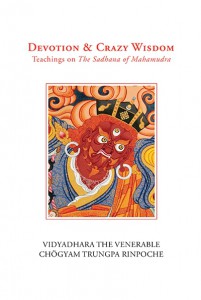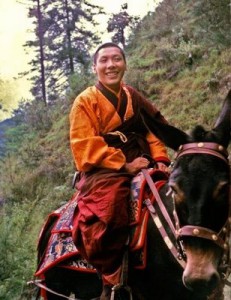Thursday
Scene and HeardDevotion and Crazy Wisdom
 Reviewing the New Release of Devotion and Crazy Wisdom: Teachings on the Sadhana of Mahamudra
Reviewing the New Release of Devotion and Crazy Wisdom: Teachings on the Sadhana of Mahamudra
Available through Shambhala Media
written by Frank Ryan
In 1963 Chogyam Trungpa Rinpoche received a Spaulding scholarship to attend Oxford University. Sailing from Bombay to Tilbury aboard the P&O Line he immersed himself into Western culture. This blended with his prior, amazingly disciplined training growing up in Eastern Tibet, as well as the wisdom traditions of Kagyu, Nyingma, and Shambhala.
In 1968, when he returned to Bhutan at the invitation of Her Majesty the Queen, Ashi Kesang, all of these streams coalesced in the form of a retreat at Taktsang in the upper reaches of Paro valley.
This was a profound turning point in the planting of a genuine path of personal transformation and societal well-being leading up to the twenty-first century. With amazing deep insight Devotion & Crazy Wisdom: Teachings on The Sadhana of Mahamudra, a recent publication of Vajradhatu Press, explores the contours of how that particular retreat and the sadhana, or practice, that arose from that retreat naturally evolved.
Devotion & Crazy Wisdom draws from two seminars presented nearly forty years ago. Part One, “The Embodiment of All the Siddhas,” draws on a seminar of the same name which Chogyam Trungpa presented in Vermont in September 1975. Part Two, “The Sadhana of Mahamudra,” was a seminar given three months later in Colorado.
The book opens with a forward and introduction which brilliantly contextualize the life of the author and the Sadhana of Mahamudra liturgy itself. Chogyam Trungpa’s opening discussion of the immediate background of the sadhana is detailed and amazingly candid. As embodied by this very remarkable teacher we witness both the challenges and opportunities that existed toward the end of the last century for establishing a viable spiritual tradition in the world. The play between the traditional world of Bhutan with its medieval formality and lockstep tradition, and the vast potential and materialism of the twentieth century world he had encountered since fleeing Tibet is expressed with penetrating immediacy.
The terma (“hidden treasure”) tradition of transmitting the essence of teachings in Tibet is ordinarily shrouded in cryptic indirection but his presentation is disarmingly direct. Few are capable of describing how two of the most powerful contemplative traditions on earth can be joined in a single practice as an attempt to “create a better soup stock, a better flavoring.”
In an era fascinated with the exotic trappings of Eastern traditions, instead of focusing on such aspects of the sadhana as “the great mountain of torma, ornamented with the eight kinds of consciousness” he touches on the indispensible underpinnings of the practice. This includes the role of the teacher, devotion, crazy wisdom, and the mandala of the siddhas. The reader’s consideration is directed towards the experience, not the abstraction, of the contemporary spiritual journey.
This separates this text – as well as the complementary six video and four audio recordings of the talks – from dry scholarly analysis. Each lineage figure, each section, and every aspect, such as “luminosity,” is presented with thorough precision. Constantly underscoring the primacy of experiential understanding, his instruction is simple and direct. For instance, the understanding of the “offering section,” explained in terms of how one would cook and present a meal for others as a offering from the heart in “100 percent ethnic style” is much more compelling than the standard formulation of the seven-fold offering often found in the Mahayana tradition.
It’s striking that Part Two, “The Sadhana of Mahamudra,” doesn’t devolve into just a technical presentation of the various sections of the sadhana. Rather than the obvious flair and energy of the practice, the focus on the view is relentless. The recurrent message is: slow down, open, and appreciate the textures of your life before venturing into the supposed realm of the exotic. What is the motivation for truly giving? What are the obstacles to giving? What is the actual experience of “giving the giver?”
 The question-and-answer sections which accompany each talk underscore the approach that discovering goodness and wisdom is a collaborative process. Although the accents of the seventies reveal themselves in several questions referencing “primal screams” and Peter O’Toole movies, there’s an undeniable level of probing intelligence. Interplay between teacher and student is on full display.
The question-and-answer sections which accompany each talk underscore the approach that discovering goodness and wisdom is a collaborative process. Although the accents of the seventies reveal themselves in several questions referencing “primal screams” and Peter O’Toole movies, there’s an undeniable level of probing intelligence. Interplay between teacher and student is on full display.
The closing chapter, “Historical Commentary: Part Two” is remarkable for both its scope and candor. In the twenty-first century it’s rare to hear a Tibetan lama of this caliber note that there “was tremendous corruption, confusion, lack of faith, and lack of practice in Tibet.” Neither avoiding this truth nor dwelling on negativity, he contrasts this with the opportunity available to those in the West to act in accord with “the highest code of discipline, meditation and wisdom.”
Both the extensive Glossary and vivid illustrations provides greater depth in plumbing the depth of the sadhana itself. In a sense, the photograph of a young and vibrant Chogyam Trungpa on horseback juxtaposed to the formidable power of the temple complex of Paro Taktsang encapsulates the wisdom of Devotion & Crazy Wisdom: Teachings on The Sadhana of Mahamudra.
It is an invitation to partake in living wisdom, not static spiritual voyeurism.
~~
Order your copy at Shambhala Media.





Jun 20, 2015
Reply
Thanks for this inspiring and inspired review.
Jun 19, 2015
Reply
I wish that there were a way to order this book without having to go to Shambhala Media. For those of us in the US, buying books from Shambhala Media entails additional costs in the shipping. I don’t see the book listed as being available through the bookstore at Shambhala Mountain Center or via Amazon.
Jun 18, 2015
Reply
The book Crazy Wisdom began to penetrate and soften me up. SOM and HUM HUM HUM blasted me out of cocoon. Groundless and happiness and perfection are wonderful places to start growing up. ;-))